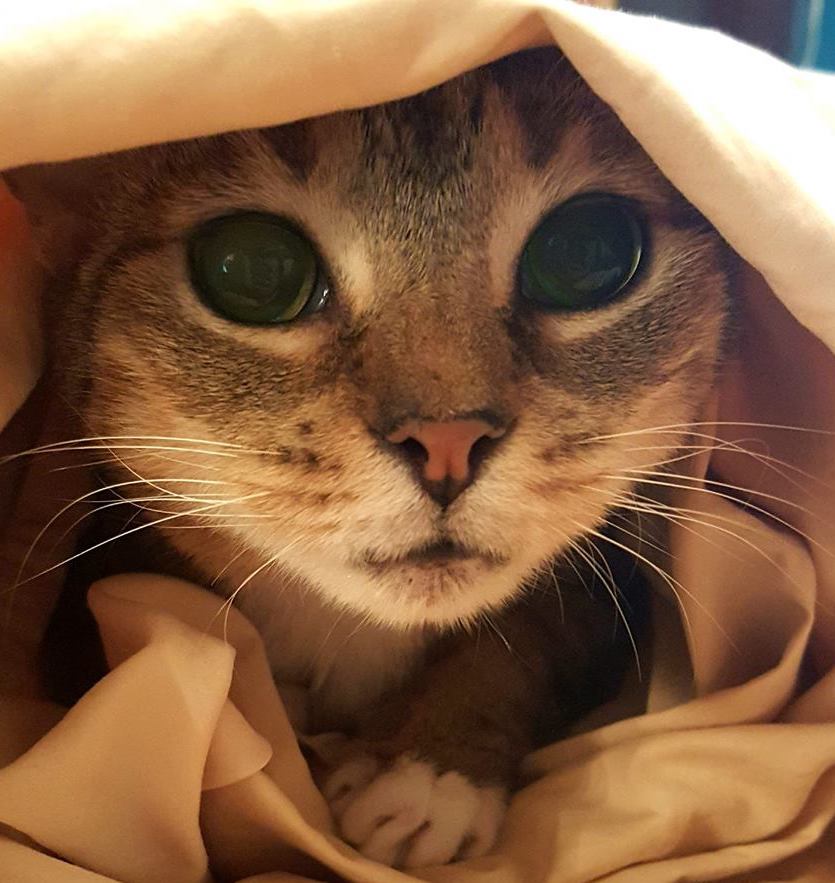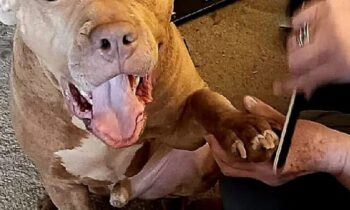
Would you walk your cat on a leash?
I didn’t ask if you could walk your cat on a leash, I asked if you would, if you knew the cat was comfortable with it? Would you like to walk your cat on a leash and have the cat enjoy the experience?
Yes, it’s possible, depending on the cat—and, even more important, depending on how you “train” the cat to accept and eventually enjoy the process.
Are you a patient person?
You’ll need some equipment:
 Collar—for ID/license/rabies tag (the leash will not be attached to the collar)
Collar—for ID/license/rabies tag (the leash will not be attached to the collar)
Measure for the collar with soft measuring tape, or use a piece of string, mark the length, and measure that.
 Harness—the leash will be attached to the harness
Harness—the leash will be attached to the harness
Measure for the harness as described by manufacturer (what gets measured depends on the style)
 Leash—6 to 10 feet; not a flexible leash; should be light, washable, easy on your hands
Leash—6 to 10 feet; not a flexible leash; should be light, washable, easy on your hands
Don’t order everything on the list yet!
This week, I’ll give you instructions on introducing the cat to the collar.
Next week, we’ll discuss getting the cat used to wearing the collar.
If you’re still hanging in there after that, we’ll move on to introducing the harness and the leash.
Then, finally, actually walking the cat on a leash.

Photo by Sara Maynard
Invest in the collar first—they’re inexpensive—because your cat should be used to wearing one even if he’s an indoor cat.
Do not put the collar on the cat yet!
Your first job is to help the cat develop some positive associations with the collar. You want the cat to be the opposite of fearful of the collar. You want the cat to be interested in and curious about the collar. You want the cat to be willing to walk right up to the collar, to touch it with a paw or nose, to “check it out” in a cat way.
How you accomplish that depends on the cat.
Does your cat have a happy place?
Is there somewhere the cat sleeps or hangs out that is especially important in the cat’s life? A favorite location, a place she knows she’s safe, a spot she’s claimed as her own?
Maybe your cat is a fan of food. Does he hang out near his bowl or feeder, does he look at you longingly every time you pass, does he suck in his cheeks to make you think he’s starving? You know what I mean!
Maybe your cat’s happy place is on your lap, next to you on the couch, at your feet in bed? Does he have more than one happy place? List all the happy places.
Then start small. Leave the collar near one of those happy places and see what happens.
That’s all. Just put the collar a few feet away from where you sit on the couch before your cat jumps up to sit next to you. Then observe.
Do nothing. Just watch.
Does the cat notice the new object? What does the cat do?
You don’t have to make notes—just observe. You’ll be getting some insights into your cat’s personality. You’ll also be practicing that patience I suggested you might need! (You might want to set some basic rules if young family members are participating in this process . . . including no interference with the cat!)
Does the cat shy away from the collar that’s a few feet away? Is the cat frightened of the collar? Does the cat run away from the collar?
You’re going to need a longer couch.
Seriously, though, you will need a lot of patience. With a cat who is clearly afraid of the collar, you may be looking at months of work and no guarantee that you and your pet will ever get to the “end” of the process, in which your pet walks happily outdoors on a leash.
You may wish to proceed at this point, or you may not.
Does the cat show immediate interest in the collar, once she’s spotted it? Is she apparently unconcerned about its presence nearby? Does she approach it willingly? Does she touch it, interact with it? You may well have a good candidate for training! At least, you’re starting with a cat who may be temperamentally suited to learning new skills and experiencing new adventures.
Is your cat’s reaction somewhere between these two extremes? That response may be closer to “normal” (whatever “normal” is!). You may need some patience to “wait out” your cat’s reactions, but it’s not hopeless, not at all. You and your cat will be learning together.
The collar—what happens next?
Again, that depends on your cat.
As the cat becomes incrementally more comfortable around the collar, move the collar incrementally closer to your cat.
Depending on the cat’s reactions, you can move the collar closer over several short “training” sessions—or leave the collar a few feet away for as long as it takes for the cat to approach it willingly, then interact with it.
You decide.
Moving ahead too quickly is usually a bigger mistake than not moving ahead too quickly. You gauge what’s working and what’s not by your cat’s reactions over a succession of repetitions. You may find yourself becoming frustrated with slow progress, but if there’s progress at all, try not to be discouraged.
Do not even think of expressing your frustration outwardly, like by yelling at the cat. If you feel a strong urge to yell at the cat during this first step of the training, I’d suggest that you might not be temperamentally suited to this process. Please don’t take it out on the cat.
Have you gone too far too fast?
Back up a few steps, to where the cat has been consistently successful, and go through the process again, more slowly. Did you miss a few days’ practice? Back up a few steps and start from there.
You want the cat to accept the collar—first a few feet away, then closer, then almost touching the cat, then . . . yes, finally, touching the cat.
Not around the cat’s neck, not buckled. Not yet!
You want the cat not to shy away. You want the cat to express acceptance of and/or interest in the collar.
Is the cat okay with the collar touching her paw?
Is the cat okay with the collar touching her leg?
Is the cat okay with the collar touching her back?
When the cat is okay with having the collar touch any part of her body, move the collar slightly when it’s on her. Advance to more collar movement when the collar is in contact with the cat.
(Movement should not equal an invitation to attack and “kill” the collar. I am talking about gentle, slow movements of the collar on or around the cat, not twitching it or tossing it around. If the cat wants to use the collar as a toy, stop any attractive movement and end the session.)
Your goal: the cat completely and totally accepts the collar’s being draped across the back of her neck, the front of her neck when she’s lying down, and so on.
At this point, attach one of the tags that will go on the collar (preferably the smallest one), then start as many steps back as you like to “accustom” the cat to the collar with its new addition.
It’s unlikely your cat will have a dramatically negative reaction to the added tag, but if he does, consider removing the tag from the collar and introducing it as a separate object, using the same process as you did with the collar, but without the collar present. Once the cat has become accustomed to the tag separate from the collar, add it back onto the collar and proceed.
Add additional tags one at a time, not all at once.
Your goal: the cat completely and totally accepts the collar, with all its tags attached, being near, on, or under her. No objections, no shying away, nothing but calm acceptance.
Next week—getting the cat used to wearing the collar. Then we’ll cover introducing the harness and the leash, getting the cat used to wearing the harness, then adding the leash.
Finally, how to introduce your cat to walking on a leash outside with the best chance of positive results for both you and for the cat!



